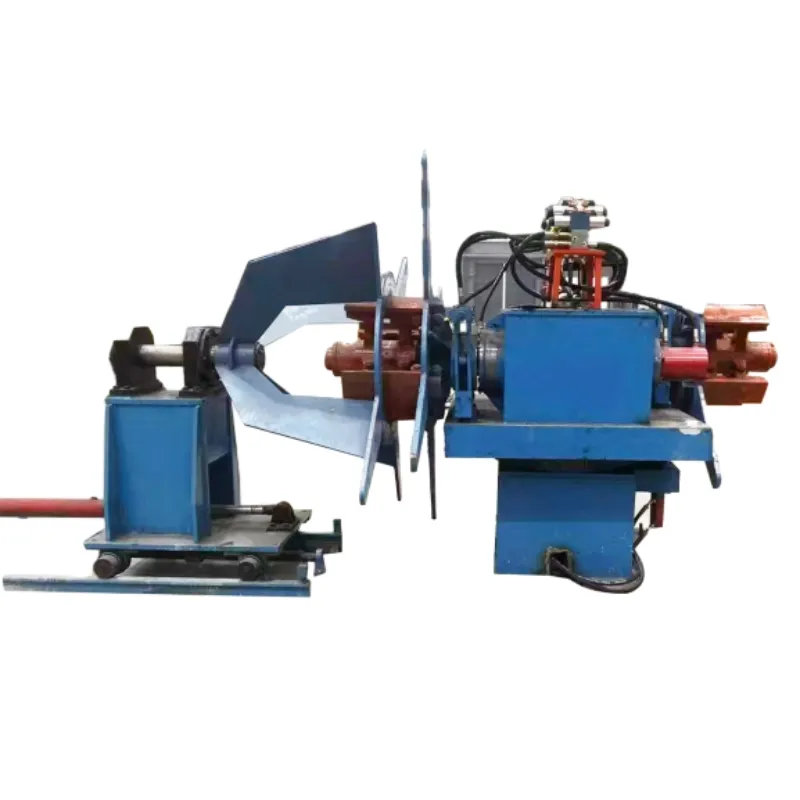uncoiler machine parts
Understanding Uncoiler Machine Parts A Comprehensive Overview
The uncoiler machine is a crucial piece of equipment in various manufacturing processes, especially in industries that involve metal processing, such as automotive, construction, and electronics. Uncoilers are designed to feed raw materials into production lines by unwinding coils of metal, plastic, or other materials. Understanding the different components of an uncoiler machine is essential for optimizing its performance and ensuring a smooth production process.
Key Parts of an Uncoiler Machine
1. Coil Holders Coil holders are integral to an uncoiler machine, as they securely support the coil during the unwinding process. They are typically adjustable to accommodate different coil sizes and weights, ensuring stability and uniformity during operation. The proper design of coil holders helps prevent damage to both the coil and the machine.
2. Winding Shaft The winding shaft is the central part of the uncoiler that holds the coil. It is typically a cylindrical metal structure that can rotate to allow for the unwinding of the material. The winding shaft must be strong enough to support the weight of the coil and be engineered to facilitate smooth rotation, which reduces wear and tear on the shaft itself.
3. Friction Brakes Friction brakes are crucial for controlling the unwinding speed of the coil. They provide the necessary resistance to prevent the coil from unwinding too quickly, which could lead to tangles or breaks. By adjusting the braking force, operators can achieve the ideal unwinding speed for different materials and specific production requirements.
4. Guiding Rollers Guiding rollers help in steering and aligning the material as it unwinds. These rollers prevent the material from twisting or misaligning, which is especially important when materials must be fed directly into a production line. The rollers are typically made of durable materials and may be adjustable to cater to different widths of coils.
5. Servo Motors A modern uncoiler machine often uses servo motors for precise control over the unwinding process. These motors enable variable speed control, allowing the operator to adjust the unwinding rate according to production needs. They contribute to the overall efficiency and effectiveness of the uncoiling process.
uncoiler machine parts

6. Base Frame The base frame serves as the foundation for the entire uncoiler assembly. It must be robust and capable of withstanding the mechanical stresses of the machine’s operation. A well-designed base frame ensures stability during operation, reducing vibrations that could affect the quality of the unwinding material.
7. Control Panel The control panel is the operator’s interface with the machine. It features various controls and displays that allow the operator to monitor and adjust settings such as speed, tension, and braking force. Advanced control panels may include digital displays, touchscreens, and even programmable features for automated operations.
Additional Components and Features
8. Tension Sensors Many uncoiler machines are equipped with tension sensors that monitor the amount of tension on the material as it unwinds. Keeping the right tension is essential for preventing damage to the material and ensuring smooth operation. Automatic tension control systems can adjust the friction brakes and motor speeds based on real-time measurements.
9. Safety Features Safety is a critical concern in any industrial setting. Uncoilers may include features such as emergency stop buttons, safety guards, and sensors that detect abnormal operation conditions. These safety measures protect operators and ensure compliance with industry regulations.
10. Maintenance Components Regular maintenance is crucial for the longevity and performance of uncoiler machines. Components such as lubrication systems, easy access panels for inspections, and wear-resistant materials can reduce downtime and maintenance costs.
Conclusion
Uncoiler machines play a vital role in various production processes by facilitating the efficient unwinding of coils. Understanding the key parts of the uncoiler not only aids in the operation and maintenance of the machine but also enhances overall productivity. By investing in a high-quality uncoiler and ensuring all components are functioning correctly, manufacturers can achieve optimal performance and reliability in their production processes. With continuous advancements in technology, modern uncoiler machines are becoming increasingly sophisticated, providing enhanced control, efficiency, and safety for industrial applications.
-
High Frequency Straight Seam Welded Pipe Production Line-BzZhou Xinghua Machinery Equipment Manufacturing Co., LTD.|Precision Welding, High EfficiencyNewsJul.30,2025
-
High Frequency Straight Seam Welded Pipe Production Line|BzZhou Xinghua|Precision Welding&EfficiencyNewsJul.30,2025
-
High Frequency Straight Seam Welded Pipe Production Line - BzZhou Xinghua|Precision Engineering&EfficiencyNewsJul.30,2025
-
High-Frequency Straight Seam Welded Pipe Production Line-BzZhou Xinghua Machinery Equipment Manufacturing Co., LTD.NewsJul.30,2025
-
High-Frequency Straight Seam Welded Pipe Production Line-BzZhou Xinghua Machinery Equipment Manufacturing Co., LTD.|Precision Manufacturing, High EfficiencyNewsJul.30,2025
-
High Frequency Straight Seam Welded Pipe Production Line-BzZhou Xinghua Machinery Equipment Manufacturing Co., LTD.|Precision Steel Pipe Manufacturing&Industrial EfficiencyNewsJul.29,2025


